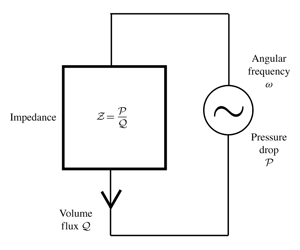Article contents
Acoustic impedance of a cylindrical orifice
Published online by Cambridge University Press: 01 April 2020
Abstract

We use matched asymptotics to derive analytical formulae for the acoustic impedance of a subwavelength orifice consisting of a cylindrical perforation in a rigid plate. In the inviscid case, an end correction to the length of the orifice due to Rayleigh is shown to constitute an exponentially accurate approximation in the limit where the aspect ratio of the orifice is large; in the opposite limit, we derive an algebraically accurate correction, depending upon the logarithm of the aspect ratio, to the impedance of a circular aperture in a zero-thickness screen. Viscous effects are considered in the limit of thin Stokes boundary layers, where a boundary-layer analysis in conjunction with a reciprocity argument provides the perturbation to the impedance as a quadrature of the basic inviscid flow. We show that for large aspect ratios the latter perturbation can be captured with exponential accuracy by introducing a second end correction whose value is calculated to be in between two guesses commonly used in the literature; we also derive an algebraically accurate approximation in the small-aspect-ratio limit. The viscous theory reveals that the resistance exhibits a minimum as a function of aspect ratio, with the orifice radius held fixed. It is evident that the resistance grows in the long-aspect-ratio limit; in the opposite limit, resistance is amplified owing to the large velocities close to the sharp edge of the orifice. The latter amplification arrests only when the plate is as thin as the Stokes boundary layer. The analytical approximations derived in this paper could be used to improve circuit modelling of resonating acoustic devices.
- Type
- JFM Papers
- Information
- Copyright
- © The Author(s), 2020. Published by Cambridge University Press
References
- 10
- Cited by




